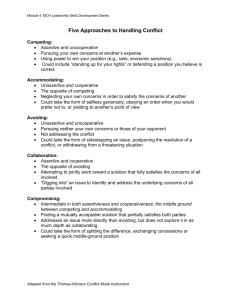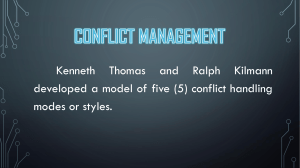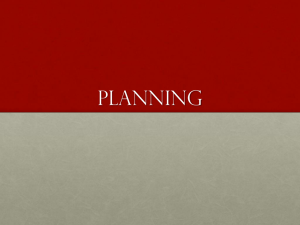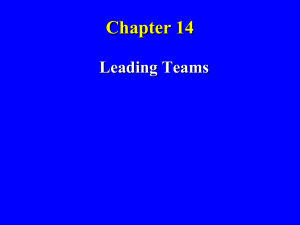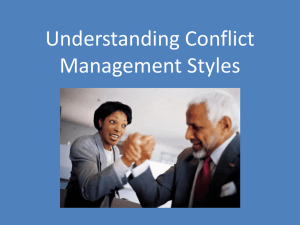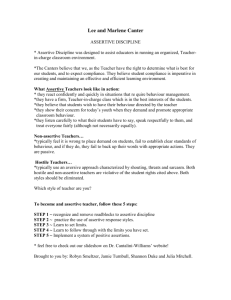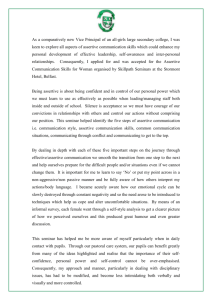Conflict Management - University of California, San Francisco
advertisement
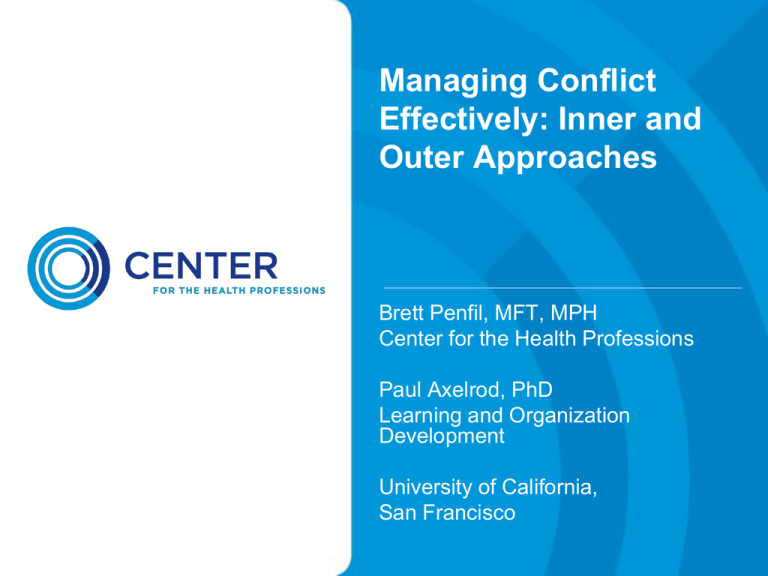
Managing Conflict Effectively: Inner and Outer Approaches Brett Penfil, MFT, MPH Center for the Health Professions Paul Axelrod, PhD Learning and Organization Development University of California, San Francisco Introduction and Outcomes • Introductions • Outcomes – Learn to frame conflict so that it appears more manageable and even desirable – Awareness of different conflict management styles – Practice new approaches to conflict management – Set one goal to develop conflict management skills 2 Agenda • An intrapersonal approach to conflict management – Constructive framing – Self-management • An interpersonal approach to conflict management – Conflict management styles – Developing a collaborative approach 3 PART 1: INTRAPERSONAL APPROACH 4 What Does Conflict Mean to You? • Turn to page 2 of your handouts. • Look at the word in the middle of the page. • Without thinking, write all the words that come to your mind when you see that word. 5 How Is Conflict Like a Volcano? 6 Conflict Is Normal and Can Be Healthy • Conflict is not inherently problematic • Conflict can be constructive or destructive • The challenge is how we manage ourselves • We are not responsible for conflict • We are responsible for how we respond to a conflict 7 Destructive Conflict Reduces productivity Diverts energy Destroys morale Polarizes groups Deepens differences Spawns additional conflict Acting-out 8 Constructive Conflict Taps creativity Generates new solutions Increases involvement Releases pentup energy Builds cohesiveness Helps individuals grow 9 How We Frame Conflict Affects How We Respond to Conflict • How we frame conflict comes from: – Our experience with conflict – Our beliefs about conflict – Our genetic makeup – Our general personality type 10 How We Respond: The Good, Bad and Ugly • Ugly: – 10% is conditioned by your history – Life is not fair • Bad: – About 70% of how we cope with perceived threats is set by our natural threshold for threat appraisal – Some people are “born to run”: lower threshold for threat appraisal • Good – 20% is affected by choices , including attitudes and approaches 11 We Can Shift Our Way of Being with Conflict New Knowledge New Awareness Regular Practice Support 12 We Get in Our Own Way • We perceive conflict in a comment, event, behavior or circumstance • Through our internal filters we see things in terms of a duality: good/bad, like/dislike, right/wrong, mine/yours • This ignites a negative feeling tone • Then feelings of confusion, ambiguity, fear, anxiety, insult, stress or intimidation: reinforcing the negative response 13 Responding to a Perceived Threat The untrained mind easily categorizes the behavior of others as a threat. This is your brain when Thisthreatened is your brain 14 Think Like a Lizard (NOT) Reactive Decision Emotional reaction Thought process Categorize something as a threat (usually unaware) 15 Responding to Threats • Great for protecting us from physical threats • Flying under the radar of consciousness • Gets in the way when the threats are thoughts in our head 16 Reflection on Framing Conflict • On your own on page 4 of your handouts: – Think of a time when you engaged in a conflict in a positive frame of mind. Note: • What factors contributed to this framing? – Think of a time when you engaged in a conflict in a negative frame of mind. Note: • What factors contributed to this framing? • With a partner: – Discuss the elements of the conflict that made it positive or negative (rather than on the details of the situations). 17 Big Group Discussion • What themes did you notice in the conversation with your partner? 18 Practicing Awareness of Thoughts and Emotions • Get out of your mind: you are not your thoughts • Focus on the physical: feel your feet and breathe from your belly • Let your emotions be: acknowledge them without getting swept up in them • Invite your demons to tea • Become more aware when you have thoughts that lead to feeling threatened, as they happen (or soon after) 19 Try This • Notice when you start to feel conflict as a threat – Practice awareness of what that feels like – and also what it feels like to relax the sense of being threatened • Be careful about making assumptions about the intentions of others – Maybe they not really out to get you. Maybe they’re just like you—a mix of motives • Try to accept your similarity with the other person – This will not weaken your position or let them off the hook, but it will make you feel better. 20 Awareness Practice 21 Also Try These • Get enough restorative sleep – – – – Avoid caffeine in the afternoon Exposure to high-intensity light Regular exercise Sleep cool • Protection against stress – Omega-3 – Folic Acid – Chosen exercise 22 Moving Forward: Some Thoughts and Tips • Moral indignation contributes to the problem: try to avoid categorizing people as jerks • Aggressive behavior is a problem to you, but to the aggressor it’s actually an attempt at a solution: your response should not just address your needs alone • What is the positive intent behind the other position? How will you find out? • When asking is not an option, discern the good intent— focus on their core truth, not judging the person or getting caught up in their words 23 Balancing Head and Heart “The key to effectively managing conflict is balance. Balance your emotions with reason. Remain balanced when attacked. Balance your desire to win with the need to bring all along. Balance confronting with knowing when to let it pass.” 24 PART 2: INTERPERSONAL APPROACH 25 Arm Wrestling Activity • Find a partner • Get into arm wrestling position • You will have 30 seconds to arm wrestle • You get a dollar every time the other person’s hand touches the table, and vice versa 26 Thomas-Kilmann Conflict Model Assertive Unassertive Uncooperative Cooperative 27 Thomas-Kilmann Conflict Model Assertive Unassertive Useful for: • Issues of low importance • Reducing tensions • Buying time • Low power Avoiding Uncooperative Cooperative 28 Thomas-Kilmann Conflict Model Assertive Competing Useful for: • Quick action • Unpopular decisions • Vital issues • Protection Unassertive Uncooperative Cooperative 29 Thomas-Kilmann Conflict Model Assertive Useful for: • Creating good will • Keeping the peace • Retreating • Low importance Accommodating Unassertive Uncooperative Cooperative 30 Thomas-Kilmann Conflict Model Assertive Compromising Useful for: • Moderate importance • Time constraints • Temporary solutions • Equal power & strong commitment Unassertive Uncooperative Cooperative 31 Thomas-Kilmann Conflict Model Assertive Unassertive Collaborating Useful for: • Integrating solutions • Learning • Merging perspectives • Gaining commitment • Improving relationships Uncooperative Cooperative 32 Thomas-Kilmann Conflict Model Assertive Competing Collaborating Compromising Unassertive Avoiding Uncooperative Accommodating Cooperative 33 Getting to COLLABORATE C O N T R O L COMPETE COLLABORATE AVOID ACCOMMODATE SUPPORT 34 Your Conflict Style • With a partner, discuss these questions: – Which approach(es) do you tend to use? What makes these more comfortable for you? – Which approach(es) do you not use? What makes these less comfortable for you? – How might you identify situations when another approach might be helpful? Page 5 of your handouts. 35 Conflict Role Play With a partner: • Read your part. • Improvise the conflict conversation based on your character. With your table: • What went well in your role plays? • What did not go so well? 36 Big Group Role Play Debrief • What helps conflict be constructive? 37 Your Conflict Situation • Think about a conflict that you are currently facing or have dealt with recently. • Take a few notes about this conflict on page 6 of your handouts. • We will be asking you to reflect on this situation. 38 Managing Conflict When You Need to Collaborate Build Common Ground Agree on a Course of Action Acknowledge and Address Emotions Understand Problem and Identify Solutions 39 40 Acknowledge and Address Emotions 41 Understand Problem and Identify Solutions 42 Agree on a Course of Action 43 Applying the Steps to Your Conflict • Consider the same situation you wrote about earlier. • On page 7 of your handouts, consider these questions: – What is the common ground? – What are your feelings? – What do you think the other person is feeling? – What is the real problem? – What are possible solutions? – What is your proposed course of action? 44 Essential Ingredients to Development Clear Goal Support Specific action steps Integration Regular practice Reflection Developing Your Coaching Skills: Example of a Goal • Goal: Empathy • Action: Once/day I will reflect to myself about what I think someone else may be feeling • Duration: One month • Evaluation: Each week, I will reflect on the impact of this practice on me • Support: I will email my reflection to my friend each day for accountability Your Conflict Goal On page 8 of your handouts, write your own goal. 47
